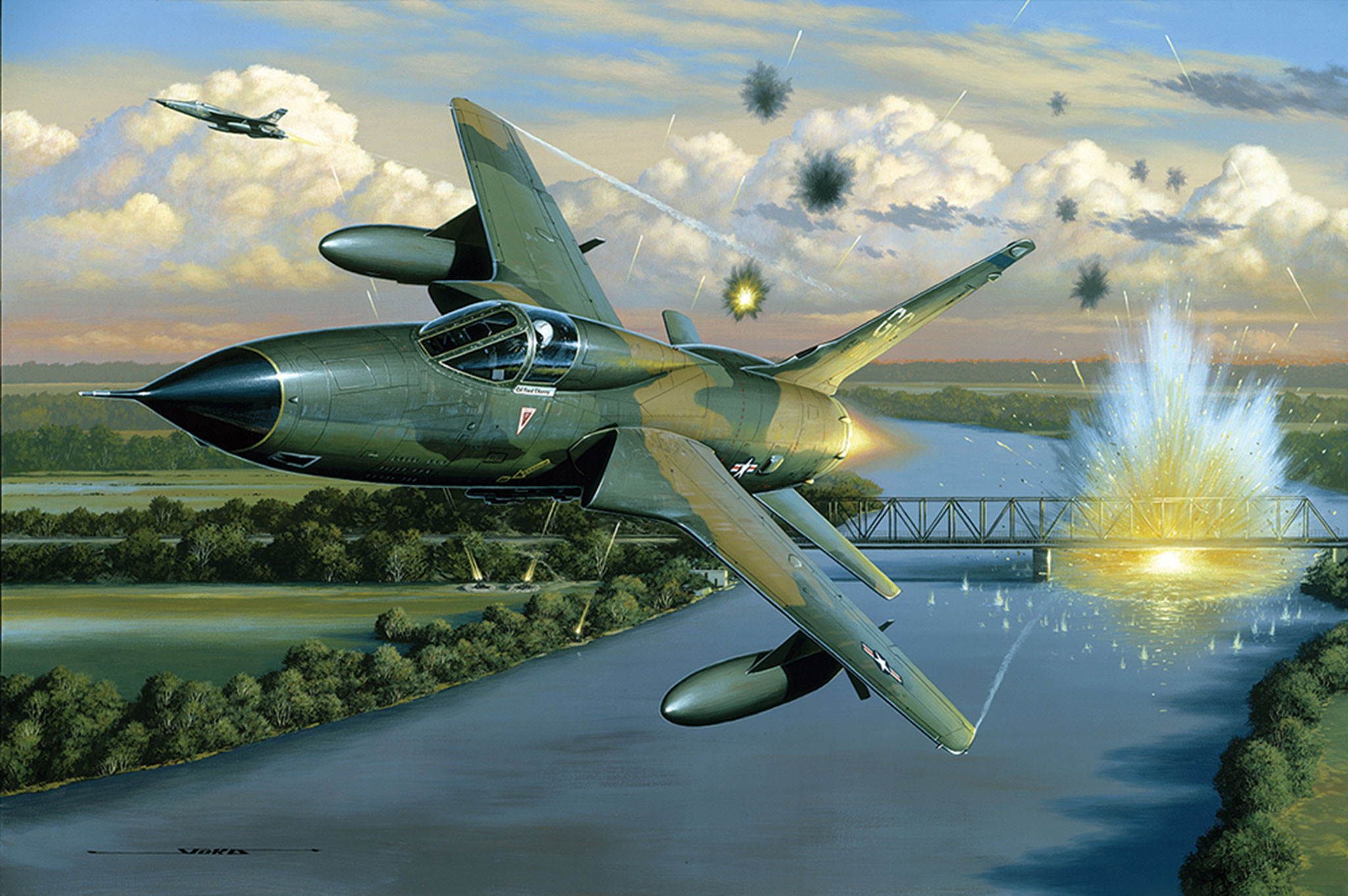In 1951, Republic Aviation began a project to replace its F-84. The prototype flew on Oct. 22, 1955. The F-105 was delivered to the USAF in 1958. Staying with its “Thunder” names (the P-47 Thunderbolt and the F-84 Thunderjet), the plane was called the Thunderchief. It was the largest single seat, single engine combat in history. It was designed to be an all-weather fighter-bomber that delivered nuclear bombs at low altitude and high speed. A reporter summed up its planned usage: “The Air Force rates the Thunderchief as the most devastating system of destruction ever controlled by one man.” Thankfully, the aircraft was never used for the mission it was designed for, but it did fly with nuclear bombs in its bomb bay. It could reach Mach 2. Maneuverability was not a priority. “No s***”, the pilots would say. (Incredibly, the F-105 was selected as the new Thunderbirds plane. It managed just six shows before a fatal accident ended the experiment.)
The plane got off to a rough start with several problems that did not endear it to its pilots. It acquired its nickname “Thud” allegedly because that was the noise the plane made when it slammed into the ground. Another version of the story was it was named after Chief Thunderthud from the Howdy Doody Show. Other nicknames included: the Squat Bomber, Lead Sled, Hyper Hog, and Ultra Hog. The early pilots referred to the plane as Triple Threat: “it could bomb you, strafe you, or fall on you.” Eventually, the problems were solved and the F-105D became the variant that flew in the Vietnam War. Pilots learned to love the plane because of its good electronics, good performance at high speed and low altitude, and responsive controls.
The Thud played a major role in Operation Rolling Thunder, the bombing of targets in North Vietnam. It flew over 20,000 sorties from Korat and Takhli air bases in Thailand. Missions usually involved attempts to stop the flow of supplies to South Vietnam and attacks on factories or bridges. President Johnson and Secretary of Defense MacNamara had to approve the targets. Once a target was chosen, it had to be hit it however many times it took to destroy it, making each attempt more hazardous than the last. The pilots chafed under the ridiculous rules of engagement that put a 30-mile radius no bomb zone around Hanoi and a 10-mile zone around the port of Haiphong where all the Russian and Chinese supplies came in, including the SAMs. Power plants and airfields were off-limits. The airfields that were home to the MiGs that tried to shoot them down.
382 of them went down (62 from accidents). Although primarily used as a bomber, pilots did accumulate 27.5 shoot- downs of MiG -17s. All were from the 20 mm. Gatling gun in its nose except 3 taken down by Sidewinder missiles. Two pilots were awarded Medals of Honor. Capt. Merlyn Dethlefsen flew a damaged Wild Weasel and stuck around long enough to take out a SAM site. Capt. Leo Thorsness covered for a rescue effort of a downed Wild Weasel. He and his EWO shot down two MiGs and then acted as a decoy.
A typical mission would call for two 450 gallon wing tanks, a 390 gallon tank in the bomb bay, and either five 1,000 pound or six 750 pound bombs. It could carry a bomb load larger than the B-17s and B-24s of WWII. Even with all that fuel, the Thuds still had to do airborne refueling. A retractable refueling probe made that easy. These were dangerous missions because of concentrations of anti-aircraft artillery and SAMs (surface to air missiles). North Vietnam had the best air defenses in the world. It is estimated that only 75% of Thud pilots completed 100 missions. The SAMs caused Republic to modify the Thud to carry a pilot and an Electronics Warfare Officer. These planes were called Wild Weasels and they were the first SEAD (suppression of enemy air defenses) planes in history. The idea was to detect a SAM site and fire a Shrike missile at it.
The F-105 Thunderchief was the workhorse of the Vietnam War. The pilots did a very dangerous job in a plane that was not designed for the missions. Many paid for it with their lives. Lives lost with gloves on.
https://en.wikipedia.org/wiki/Republic_F-105_Thunderchief
https://www.airplanes-online.com/f105-thunderchief.htm
https://www.flightmuseum.com/explore/f-105d/
https://www.smithsonianmag.com/air-space-magazine/thuds-the-ridge-and-100-missions-north-47278311/

0 Comments